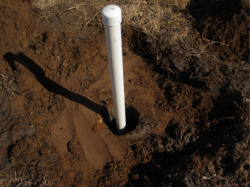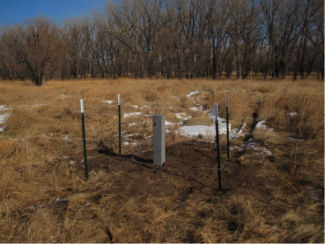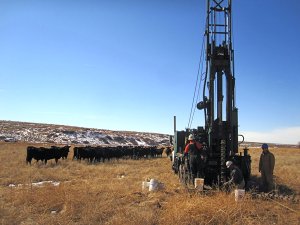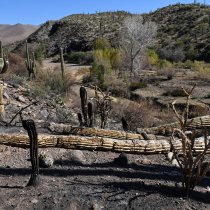Windows into unseen waters
April 24, 2012
By Michael Fitzgerald
For most people, water is just something that comes out of a faucet in their house. We pay little attention to how it gets there. For some of us, though, water and especially groundwater is a continual point of focus. Groundwater moves almost as slowly as paint dries, yet it’s super fascinating to a few of us and important to all of us. Water is extremely important to life on this planet. Finding freshwater is a challenge to many of the inhabitants on earth, particularly in poorer regions. Even though the surface of the earth is roughly 70 percent covered by water, the vast majority of this water is salty ocean water. Freshwater amounts to just three percent of the Earth’s total water, and about a third of freshwater is groundwater. Groundwater is an important part of our tiny usable water supply, and we need to monitor it.

Well in ground soil
I am a hydrologist here at NEON, which means I work with surface water (like that in lakes and streams) and groundwater.
My background is in hydrogeology, which means I focus on the water that we can’t easily observe: the water that’s held within the soils and rocks below our feet. We can’t observe it directly, so to study it, we put fancy straws into the ground. In mid-February, while many other people were wooing their significant others for Valentine’s Day, we were hard at work establishing the first portion of NEON’s groundwater observation well network. The first wells are part of the Central Plains region (Domain 10) and are situated around the Arikaree River in eastern Colorado. The site is a pristine grasslands area which has a gentle topography of rolling hills with a small portion of the Ogallala Formation present along the southern boundary. NEON collaborated with the U.S. Geological Survey to install the wells at the site. Initial characterization of the site, performed by the USGS, used a combined geophysics approach to attempt to define the anticipated depth that we would need to drill the wells. In other words, we used electricity to look for water. For those of you who haven’t used electrical resistivity (a geophysics method) to study aquifers before, here’s how it works: We apply a small amount of electrical current to the soil though a pair of electrodes and measure the resulting electric potential at a separate set of electrodes. Several electrodes are positioned in a line and the current and electrode pairs are automatically swapped around many times through all the electrodes. If you do this enough, swapping the current pair of electrodes and potential pair, what you get are a set of measurements that yield a map of the soil’s ability to conduct electricity.
We use a fancy numerical modeling technique called an “inversion” which takes the raw data that we collect from the electrodes and computes what the subsurface architecture must look like to yield the electrical signals we collected. The reason this works so well is that water conducts electricity and we can “image” underground soils and soil moisture this using this technique. More accurately, we can use this technique to look for differences in the electrical conductance of the soil layers and make inferences as to where there is water or at least a shift in the underlying layers. We also make some eye-catching images.
The water table, or the minimum distance between the ground surface and available groundwater, fluctuates due to seasonal variations of input (i.e. rain and snow melt) and extraction (i.e. irrigation and drinking water). The wellxs were constructed to allow for the full range of seasonal oscillation in the groundwater table to be observed. During the drilling operations we observed the water table at about 5 feet below the ground surface and anticipated that the water table could lower by up to 15 feet below current level if irrigation increased and rain and snow pack in the mountains decreased over the next few decades. Historic information on the groundwater level fluctuations around the stream was not available before we installed the wells. So we opted to use a slotted pipe 15 feet in length and positioned from 10 to 25 feet below ground surface to allow for substantial fluctuations in the water table and still have the well intersect it.

And finally, we have NEON’s first groundwater observation well. In the coming months the NEON aquatic team will be installing sensors in the wells and in the stream to begin prototyping activities of the sensors and their data streams. Once we install water level sensors in the wells we’ll be able to track the oscillation of the groundwater table and will begin to establish the historical groundwater record in this region. The data collected through this network will establish a database that will allow local farmers to track the generalized effects of irrigation on groundwater levels in the region. This data will also be useful to the greater scientific research community as a part of the puzzle piece for examining continental scale ecological drivers and responses, among many other potential studies. Stay tuned for more developments!

